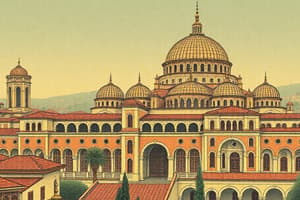Podcast
Questions and Answers
في الفجر، أرسل السلطان محمد رسالة إلى الناس الذين كانوا يدافعون عن المدينة مخبراً إياهم أنه مالم يفتحوا خلال ثلاث ساعات، فسيرسل بالهجوم باستخدام كل الوسائل المتاحة — وهو ما يعني 17 قطعة ______ موجهة ضد أجزاء مختلفة من نظام التحصين.
في الفجر، أرسل السلطان محمد رسالة إلى الناس الذين كانوا يدافعون عن المدينة مخبراً إياهم أنه مالم يفتحوا خلال ثلاث ساعات، فسيرسل بالهجوم باستخدام كل الوسائل المتاحة — وهو ما يعني 17 قطعة ______ موجهة ضد أجزاء مختلفة من نظام التحصين.
مدفعية
هناك أسباب مختلفة تم اقتباسها لسقوط القسطنطينية. يقول بعض المؤرخين أنه كان بسبب مشاكل ______ مثل المشاكل المالية والصراعات السياسية بين الطبقة الحاكمة، والصراعات الدينية بين الكنيسة الأرثوذكسية والكرسي الرسولي في روما.
هناك أسباب مختلفة تم اقتباسها لسقوط القسطنطينية. يقول بعض المؤرخين أنه كان بسبب مشاكل ______ مثل المشاكل المالية والصراعات السياسية بين الطبقة الحاكمة، والصراعات الدينية بين الكنيسة الأرثوذكسية والكرسي الرسولي في روما.
داخلية
بعض المفسرين يلومون العوامل ______ مثل صعود العثمانيين وسياساتهم التوسعية وكذلك ضعف البيزنطيين أنفسهم - نقص سلاح متقدم مقارنة بأوروبا الغربية واعتمادهم على الأساليب التقليدية التي ثبتت عدم كفايتها ضد تقنيات الحرب الحديثة المستخدمة من قبل الغزاة.
بعض المفسرين يلومون العوامل ______ مثل صعود العثمانيين وسياساتهم التوسعية وكذلك ضعف البيزنطيين أنفسهم - نقص سلاح متقدم مقارنة بأوروبا الغربية واعتمادهم على الأساليب التقليدية التي ثبتت عدم كفايتها ضد تقنيات الحرب الحديثة المستخدمة من قبل الغزاة.
خارجية
تشير مدرسة فكر أخرى إلى كيف أن الحروب الأهلية المستمرة ضعفت دفاعات الإمبراطورية بينما كانت لها أيضًا تأثير مقلق على اقتصادها، مما أدى بها إلى الانحدار قبل وصول الترك العثمانيين.
تشير مدرسة فكر أخرى إلى كيف أن الحروب الأهلية المستمرة ضعفت دفاعات الإمبراطورية بينما كانت لها أيضًا تأثير مقلق على اقتصادها، مما أدى بها إلى الانحدار قبل وصول الترك العثمانيين.
بالإضافة إلى ذلك، يقترح بعض العلماء أن الفترة الوسطى المتأخرة شهدت تقليصًا في طرق التجارة التي تمر من خلال المنطقة، مما أدى إلى تقليل النشاط الاقتصادي والمساهمة في انهيار الإمبراطورية.
بالإضافة إلى ذلك، يقترح بعض العلماء أن الفترة الوسطى المتأخرة شهدت تقليصًا في طرق التجارة التي تمر من خلال المنطقة، مما أدى إلى تقليل النشاط الاقتصادي والمساهمة في انهيار الإمبراطورية.
Flashcards are hidden until you start studying
Study Notes
The Fall of Constantinople
Constantinople was once one of the most powerful cities on Earth, serving as the capital of the Roman Empire's Eastern half from its founding by Emperor Konstantinos I in AD 330 until it fell nearly thirteen centuries later. Its fall is considered a turning point in world history as it marked the end of the Byzantine Empire. Here, we will explore why this great city eventually succumbed.
A City Built To Last
The city was designed with defense in mind. It had thick brick walls, wide moats filled with water and spikes, vast underground tunnels to house soldiers, and huge towers along the ramparts. These features were so impressive that they awe visitors even today. However, despite these precautions, it wasn't enough to hold off one of the greatest military forces of all time—the Ottoman Turks.
The Siege Of Constantinople
In 1453, Sultan Mehmed II decided to put his enormous army against the walls of Constantinople after several failed attempts. His plan involved building a massive wooden tower known as the 'Tower of Wood', which could fire artillery over the city wall's edge. This allowed his troops to make their assault without being exposed to enemy archery. In addition, he used rams and battering rams to break down sections of the walls.
Despite four months of intense struggle, including dozens of sorties where Christian knights tried to sack the Muslim camp, the defenders finally surrendered on May 29th, 1453. At dawn, Sultan Mehmed sent a message to the people who had been defending the city telling them that unless they opened up within three hours, he would attack using every means available — which meant 17 cannon pieces directed against different parts of the fortification system.
Reasons For The Fall
There are various reasons cited for the fall of Constantinople. Some historians argue that it was due to internal problems such as financial troubles, political infighting among the ruling class, and religious strife between the Orthodox Church and the Holy See in Rome. Others blame external factors like the rise of the Ottomans and their expansionist policies as well as the weaknesses of the Byzantines themselves - their lack of advanced weaponry compared to Western Europe and their reliance on traditional methods that proved insufficient against modern warfare techniques deployed by the invaders.
Another school of thought points out how constant civil wars weakened the empire’s defenses while also having a destabilizing effect on its economy, leading it into decline before the arrival of the Ottoman Turks. Additionally, some scholars suggest that the late medieval period saw a reduction in trade routes going through the region, reducing economic activity and contributing to the collapse of the empire.
Aftermath And Legacy
After the conquest, Constantinople became Istanbul, the largest city in Turkey and one of the most populous urban areas in the world. The Ottoman Turks continued their expansion, creating an empire that stretched across southeastern Europe, northwestern Africa, western Asia, central Asia, and the Middle East. Their reign lasted five centuries, only ending when they lost World War I.
However, the legacy of Constantinople lives on. Today, many argue that if Constantinople hadn't fallen, traditional Christianity might have split into two separate entities rather than becoming divided into Catholicism and Protestantism; thus, the conversion of much more of the globe to Christianity may have proven impossible.
Studying That Suits You
Use AI to generate personalized quizzes and flashcards to suit your learning preferences.




